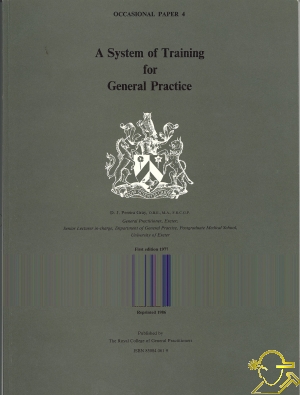A System of Training for General Practice
İÇİNDEKİLERContentsPREFACE TO SECOND EDITION SECTION 1 ^INTRODUCTION Detinitions Author Three priorities for universities SECTION 2 THE DEVELOPMENT OF VOCATIONAL TRAINING FOR GENERAL PRACTICE (1) Historical (2) Political (3) Comparisons with other branches of medicine SECTION 3 EDUCATIONAL THEORY The educational paradigm or model The triangle of training 1. Aims (a) Aids for the learner (b) Aids for the teacher (c) Clarification (d) Requirements for assessment (e) Requirements for comparisons 2. Methods 3. Assessment (a) Aids for the learner (b) Aids for the teacher (c) Aids for the sponsor (d) Requirement for comparisons General principles for promoting learning (a) Learner-centred course (b) Participation (c) Discovery learning (d) Learning from peers (e) Reinforcement (f) Appropriate atmosphere Additional principles specially relevant to general practice (a) Particularising and generalising (b) Doctor/patient and trainer/trainee (e) Practical problems SECTION 4 AIMS AND OBJECTIVES Leeuwenhorst Working Party (1) Job description of the general practitioner (2) Educational aims Knowledge Skills Attitudes Aims of the Exeter Department of General Practice Importance of attitudes Two examples from a London medical school SECTION 5 METHODS Organisation (1) Staff (a) Organisers as educationalists (b) Paying medical teachers (c) General-practitioner organisers (2) Premises (3) Academic prizes (4) Selecting trainers and training practices Attachments (5) Hospital posts (a) Choosing hospital posts (b) Sequence of hospital posts (c) Duration of hospital posts (6) Training courses (a) Introductory courses (b) The main release course Do-it-yourself or three-year programmes ? (c) Additional courses Evening seminars on the doctor-patient relationship MRCGP course Practice management course Videotape analysis of the consultation (7) Group work (a) Trainers' workshop (b) Intensive trainers' course (c) Trainee group Examples (8) Ways of learning (a) Lectures (b) Group work (modelling) Example (c) Individual learning (d) The individual tutorial (one-to-one teaching) Ten examples of tutorials with vocational trainees in one training practice. SECTION 6 ASSESSMENT Classification of types of assessment Use of assessment in higher medical training Objective methods of assessment (a) Knowledge (b) Skills (c) Research projects (d) Attitudes (e) External assessments Subjective methods of assessment (a) Continuous (b) Group work (c) Assessing trainee consultations SECTION 7 CONCLUSION SECTION 8 ACKNOWLEDGEMENTS SECTION 9 REFERENCES    |



